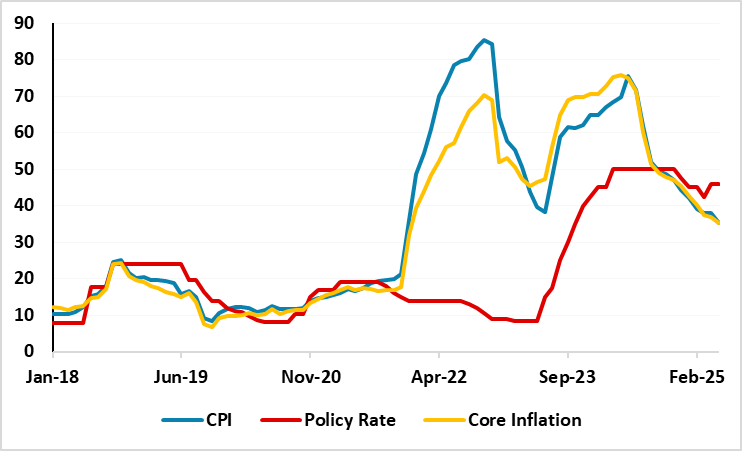Turkiye’s Inflation Eased to the Lowest Since November 2021 with 35.4% YoY in May
Bottom line: Turkish Statistical Institute (TUIK) announced on June 3 that the inflation softened to 35.4% y/y in April from 37.9% y/y in April. We think monetary tightening, fiscal measures and suppressed wages helped relieve the price pressure. Despite this, inflationary risks remain tilted to the upside and we believe deteriorated pricing behaviour, the stickiness of services inflation, and adverse geopolitical developments coupled with hikes in electricity and natural gas prices in April, and currency volatility after Istanbul mayor Imamoglu’s arrest will likely lead to average headline inflation to stand at 31.9% in 2025. Despite the Central Bank of Turkiye (CBRT) predicts inflation will soften to 24% at the end of 2025, the road will be bumpy due to risks.
Figure 1: CPI, Core Inflation (YoY, % Change) and Policy Rate (%), January 2018 – May 2025

Source: Continuum Economics
The deceleration trend in inflation continued in Turkiye in May, and inflation rate softened for twelve consecutive months. CPI cooled off to 35.4% y/y May from 37.9% in April with education and housing prices leading the rise in the index. MoM inflation rose by 1.5% in May, lower than 3.0% MoM inflation the previous month. Core inflation rose by 2.4% MoM, bringing the annual rate down to 35.4%. PPI rose 2.5% MoM in May for an annual rise of 23.1%, the data showed.
Education prices recorded the highest annual increase with 71.7% YoY followed by housing prices were up by 67.4% YoY. Prices rose at a slower pace across a number of categories, such as footwear and clothing, which came in at 14.1% YoY in May.
We think lagged impacts of previous monetary tightening, fiscal measures and less-than-expected hike in minimum wage in January continued to relieve the price pressure in May. Despite this, hikes in electricity and natural gas prices in April, and currency volatility after Istanbul mayor Imamoglu’s arrest contributed to the spike in the monthly inflation to 1.5% in May.
It is worth noting that CBRT released the second quarterly inflation report of the year on May 22, and maintained its end year-end inflation forecast at 24%. Inflation forecast was set at 12% for 2026, 8% for 2027, and the inflation report mapped out a gradual path toward its medium-term objective of 5% inflation. CBRT governor Karahan highlighted that CBRT maintained its forecast range for this year between 19% and 29%, citing the recent rise in uncertainties. The governor also signalled to keep a tight stance until a permanent decline in inflation is sustained and price stability is achieved, reaffirming CBRT will adjust interest rates on a meeting-by-meeting basis on data-driven decisions.
Taking into account that the key concern remains service sector inflation, particularly in housing rentals, and education prices, Karahan emphasized that "Despite the recent moderation, uncertainties surrounding global trade and economic policies remain elevated. While these uncertainties increase downside risks to global growth, potential inflationary effects vary across countries."
We continue to think inflationary risks remain tilted to the upside. We believe deteriorated pricing behaviour, the stickiness of services inflation, and adverse geopolitical developments particularly Trump tariffs will likely lead to average headline inflation to stand at 31.9% in 2025. Despite the CBRT predicts inflation will soften to 24% at the end of 2025, the road will be bumpy due to risks.